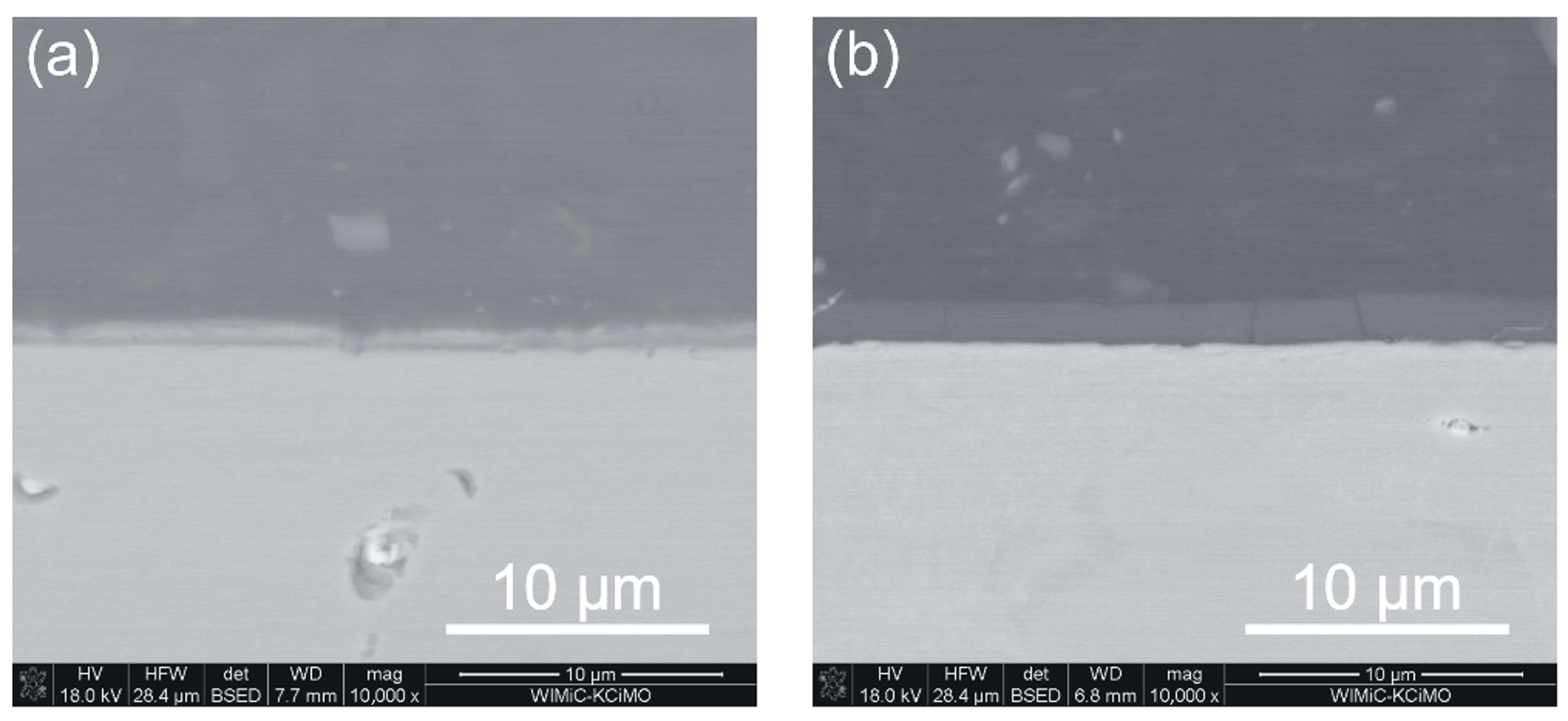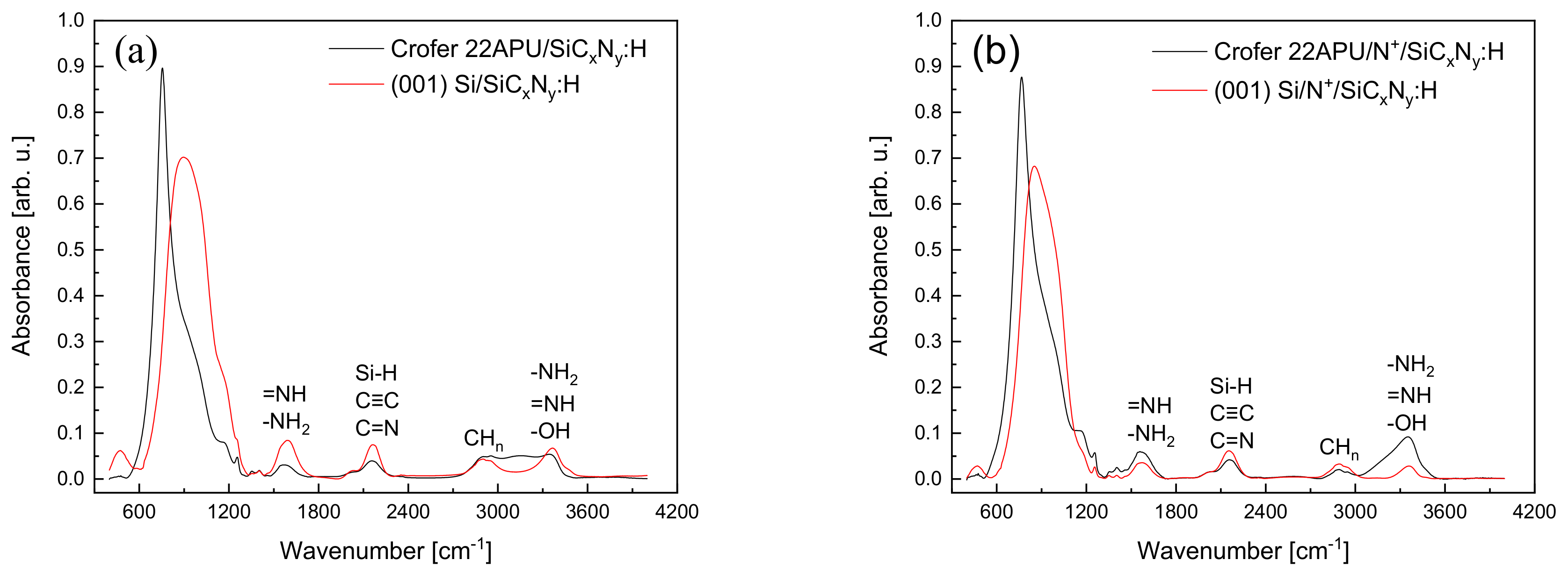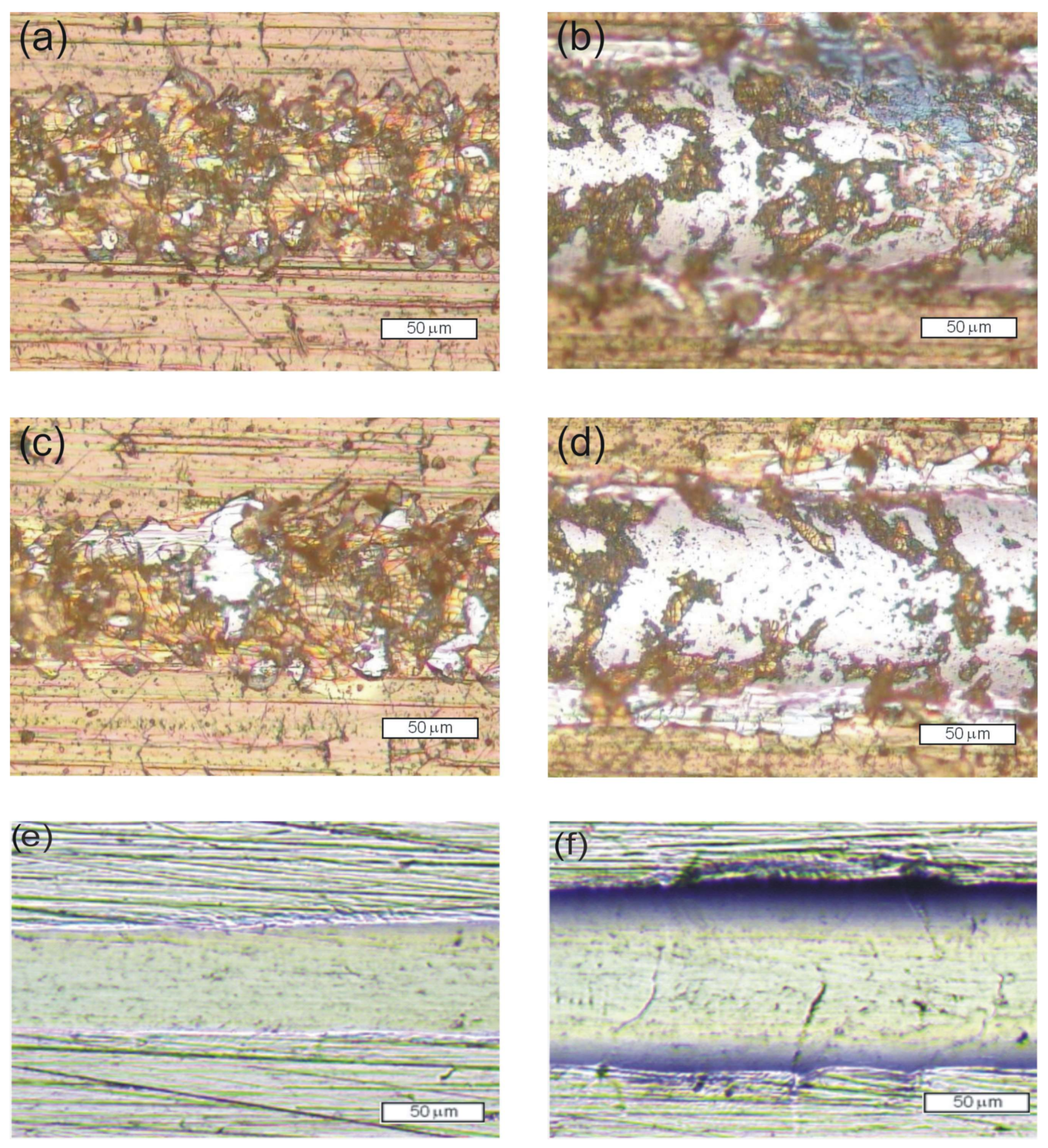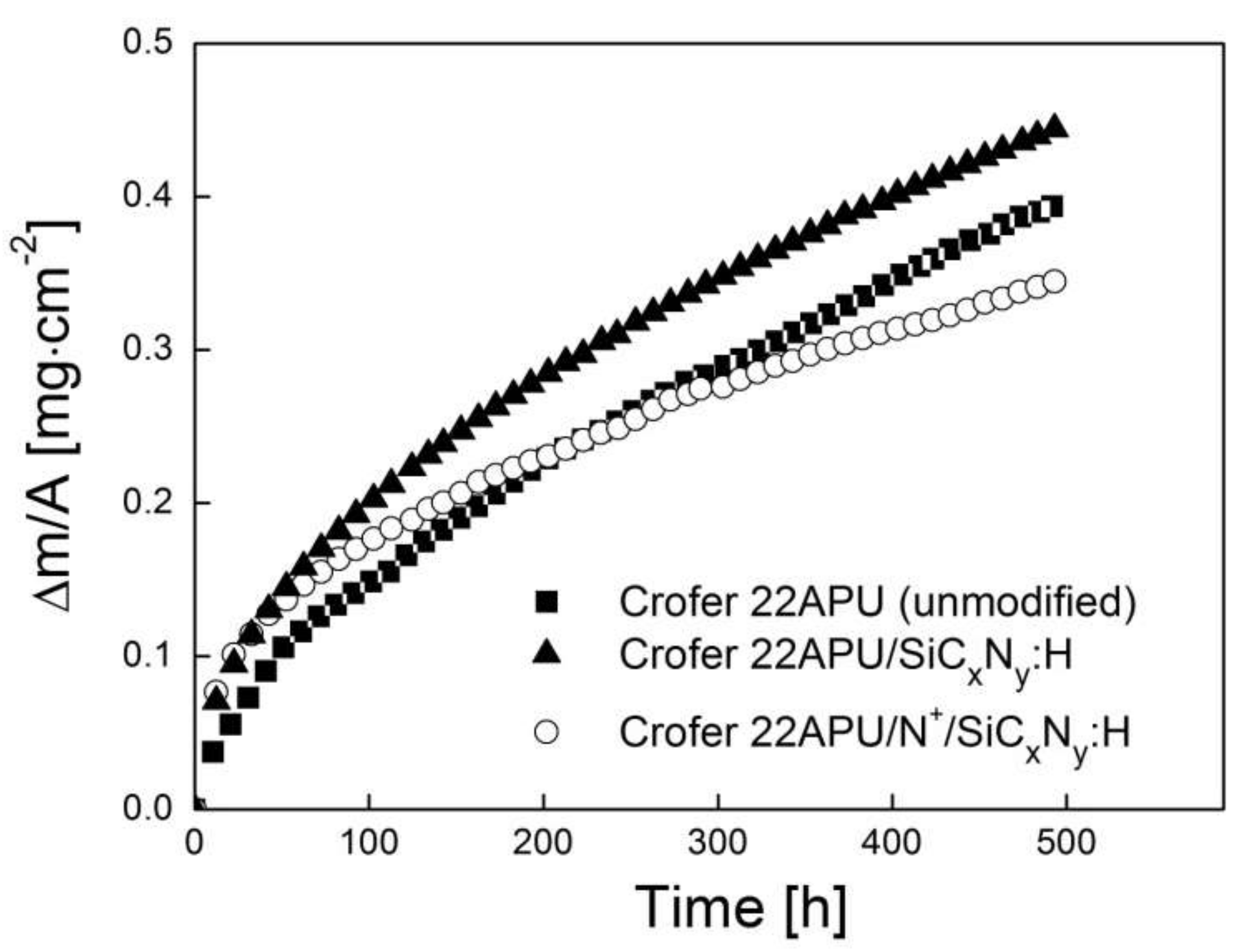Plasmochemical Modification of Crofer 22APU for Intermediate-Temperature Solid Oxide Fuel Cell Interconnects Using RF PA CVD Method
Abstract
:1. Introduction
2. Experimental Procedure
2.1. Material Preparation
2.2. Research Methods
3. Results and Discussion
3.1. Chemical Composition and Surface Parameters
3.2. Mechanical and Tribological Properties
3.3. Corrosion Study
3.4. Electrical Properties
4. Conclusions
- N+ ion modification decreases the modified steel substrate wear resistance ca. 7 times compared to the value obtained from the material with only the SiCxNy:H layer.
- Micromechanical experiments demonstrated that plasmochemical modification significantly influences the mechanical properties (hardness and Young’s modulus) of the materials.
- Oxidation kinetics measurements performed for an oxidation time of 500 h and a temperature of 1073 K indicate that prior N+ ion modification in plasmochemical conditions results in improved corrosion resistance of the Crofer 22APU steel with the deposited SiCxNy:H layer.
- Structural, microstructural, and chemical composition studies performed by means of XRD and SEM-EDS revealed the presence of a dual-layer scale composed of chromia and the MnCr2O4 spinel as the outer layer.
- Based on electrical conductivity measurements of the Crofer 22APU (unmodified)/scale, Crofer 22APU/SiCxNy:H and Crofer 22APU/N+/SiCxNy:H layered systems in the temperature range of 623–1023 K in air, it was determined that the deposition of the ceramic layer on the surface of the Crofer 22APU improves the electrical properties of the studied ferritic steel.
- The steel sample surface-modified via N+ ion modification and the deposition of the SiCxNy:H layer and oxidized in the aforementioned conditions exhibited the lowest ASR value, i.e., 0.01 Ω·cm2.
Author Contributions
Funding
Institutional Review Board Statement
Informed Consent Statement
Data Availability Statement
Acknowledgments
Conflicts of Interest
References
- Shi, Y.; Cai, N.; Cao, T.; Zhang, J. High-temperature electrochemical energy conversion and storage. In Fundamentals and Applications; CRC Press: Boca Raton, FL, USA, 2018. [Google Scholar]
- Kendall, K.; Kendall, M. High-temperature solid oxide fuel cells for the 21st century. In Fundamentals, Design and Applications; Academic Press: Amsterdam, The Netherlands, 2016. [Google Scholar]
- Zhu, W.Z.; Deevi, S.C. Development of interconnect materials for solid oxide fuel cells. Mater. Sci. Eng. A 2003, 348, 227–243. [Google Scholar] [CrossRef]
- Yang, Z.; Weil, K.S.; Paxton, D.M.; Stevenson, J.W. Selection and Evaluation of Heat-Resistant Alloys for SOFC Interconnect Applications. J. Electrochem. Soc. 2003, 150, A1188–A1201. [Google Scholar] [CrossRef]
- Fergus, J.W. Metallic interconnects for solid oxide fuel cells. Mater. Sci. Eng. A 2005, 397, 271–283. [Google Scholar] [CrossRef]
- Molenda, J.; Kupecki, J.; Baron, R.; Blesznowski, M.; Brus, G.; Brylewski, T.; Bucko, M.; Chmielowiec, J.; Cwieka, K.; Gazda, M.; et al. Status report on high temperature fuel cells in Poland—Recent advances and achievements. Int. J. Hydrogen Energy 2017, 42, 4366–4403. [Google Scholar] [CrossRef]
- Huczkowski, P.; Quadakkers, W.J. Effect of Geometry and Composition of Cr Steels on Oxide Scale Properties Relevant for Interconnector Applications in Solidoxide Fuel Cells (SOFCs). Ph.D. Thesis, Schriften des Forschungszentrums, Jülich, Germany, 2007. [Google Scholar]
- Quadakkers, W.J.; Piron-Abellan, J.; Shemet, V.; Singheiser, L. Metallic Interconnectors for Solid Oxide Fuel Cells—A Review. Mater. High Temp. 2003, 20, 115–127. [Google Scholar]
- Brylewski, T.; Nanko, M.; Maruyama, T.; Przybylski, K. Application of Fe-16Cr ferritic alloy to interconnector for a solid oxide fuel cell. Solid State Ion 2001, 143, 131–150. [Google Scholar] [CrossRef]
- Grolig, J.G.; Froitzheim, J.; Svensson, J.E. Coated stainless steel 441 as interconnect material for solid oxide fuel cells: Oxidation performance and chromium evaporation. J. Power Sources 2014, 248, 1007–1013. [Google Scholar] [CrossRef] [Green Version]
- Liu, W.N.; Sun, X.; Stephens, E.; Khaleel, M.A. Life prediction of coated and uncoated metallic interconnect for solid oxide fuel cell applications. J. Power Sources 2009, 189, 1044–1050. [Google Scholar] [CrossRef]
- Molin, S.; Chen, M.; Hendriksen, P.V. Oxidation study of coated Crofer 22APU steel in dry oxygen. J. Power Sources 2014, 251, 488–495. [Google Scholar] [CrossRef]
- Ghali, S.; Ahmed, A.; Mattar, T. High temperature oxidation of Cr-steel interconnects in solid oxide fuel cells. Int. J. Innov. Sci. 2017, 11, 282–288. [Google Scholar]
- Brouzgou, A.; Demin, A.; Tsiakaras, P. Interconnects for solid oxide fuel cells, advances in medium and high temperature solid oxide fuel cell technology. In CISM International Centre for Mechanical Sciences; Springer: Berlin/Heidelberg, Germany, 2017. [Google Scholar]
- Prikhna, T.A.; Ostash, O.P.; Kuprin, A.S.; Podhurska, V.Y.; Serbeyuk, T.B.; Gevorkyan, E.S.; Rucki, M.; Zurowski, W.; Kucharczyk, W.; Sverdun, V.B.; et al. A new MAX phases-based electroconductive coating for high-temperature oxidizing environment. Compos. Struct. 2021, 277, 114649. [Google Scholar] [CrossRef]
- Fontana, S.; Amendola, R.; Chevalier, S.; Piccardo, P.; Caboche, G.; Viviani, M.; Molins, R.; Sennour, M. Metallic interconnects for SOFC: Characterisation of corrosion resistance and conductivity evaluation at operating temperature of differently coated alloys. J. Power Sources 2007, 171, 652–662. [Google Scholar] [CrossRef]
- Bednarz, M.; Molin, S.; Bobruk, M.; Stygar, M.; Długoń, E.; Sitarz, M.; Brylewski, M. High-temperature oxidation of the Crofer 22 H ferritic steel with Mn1.45Co1.45Fe0.1O4 and Mn1.5Co1.5O4 spinel coatings under cyclic temperature conditions and its properties. Mater. Chem. Phys. 2019, 225, 227–238. [Google Scholar] [CrossRef]
- Brylewski, T.; Kruk, A.; Bobruk, M.; Adamczyk, A.; Partyka, J.; Rutkowski, P. Structure and electrical properties of Cu-doped Mn-Co-O spinel prepared via soft chemistry and its application in intermediate-temperature solid oxide fuel cell interconnects. J. Power Sources 2016, 333, 145–155. [Google Scholar] [CrossRef]
- Smeacetto, F.; De Miranda, A.; Cabanas Polo, S.; Molin, S.; Boccaccini, D.; Salvo, M.; Boccaccini, A.R. Electrophoretic deposition of Mn1.5Co1.5O4 on metallic interconnect and interaction with glass-ceramic sealant for solid oxide fuel cells application. J. Power Sources 2015, 280, 379–386. [Google Scholar] [CrossRef]
- Molin, S.; Jasinski, P.; Mikkelsen, L.; Zhang, W.; Chen, M.; Hendriksen, P.V. Low temperature processed MnCo2O4 and MnCo1.8Fe0.2O4 as effective protective coatings for solid oxide fuel cell interconnects at 750 °C. J. Power Sources 2016, 336, 408–418. [Google Scholar] [CrossRef] [Green Version]
- Falk-Windisch, H.; Claquesin, J.; Sattari, M.; Svensson, J.-E.; Froitzheim, J. Co- and Ce/Co-coated ferritic stainless steel as interconnect material for Intermediate Temperature Solid Oxide Fuel Cells. J. Power Sources 2017, 343, 1–10. [Google Scholar] [CrossRef]
- Brylewski, T.; Molin, S.; Marczyński, M.; Mazur, Ł.; Domaradzki, K.; Krysthal, O.; Gil, A. Influence of Gd deposition on the oxidation behavior and electrical properties of a layered system consisting of the Crofer 22APU and MnCo2O4 spinel. Int. J. Hydrogen Energy 2021, 46, 6775–6791. [Google Scholar] [CrossRef]
- Mazur, Ł.; Ignaczak, J.; Bik, M.; Molin, S.; Sitarz, M.; Gil, A.; Brylewski, T. Effectiveness of a dual surface modification of metallic interconnects for application in energy conversion devices. Int. J. Hydrogen Energy 2022, 47, 6295–6311. [Google Scholar] [CrossRef]
- Zanchi, E.; Ignaczak, J.; Molin, S.; Cempura, G.; Boccaccini, A.R.; Smeacetto, F. Electrophoretic co-deposition of Mn1.5Co1.5O4, Fe2O3 and CuO: Unravelling the effect of simultaneous addition of Cu and Fe on the microstructural, thermo-mechanical and corrosion properties of in-situ modified spinel coatings for solid oxide cell interconnects. J. Eur. Ceram. 2022, 42, 3271–3281. [Google Scholar]
- Zhao, Q.; Geng, S.; Zhang, Y.; Chen, G.; Zhu, S.; Wang, F. High-entropy FeCoNiMnCu alloy coating on ferritic stainless steel for solid oxide fuel cell interconnects. J. Alloys Compd. 2022, 908, 164608. [Google Scholar] [CrossRef]
- Tyagi, A.; Walia, R.S.; Murtaza, Q.; Pandey, S.M.; Tyagi, P.K.; Bajaj, B. A critical review of diamond like carbon coating for wear resistance applications. Int. J. Refract. Hard Met. 2019, 78, 107–122. [Google Scholar] [CrossRef]
- Bewilogua, K.; Hofmann, D. History of diamond-like carbon films—From first experiments to worldwide applications. Surf. Coat. Technol. 2014, 242, 214–225. [Google Scholar] [CrossRef]
- Nagai, T.; Hiratsuka, M.; Alanazi, A.; Nakamori, H.; Hirakuri, K. Anticorrosion of DLC coating in acid solutions. Appl. Surf. Sci. 2021, 552, 149373. [Google Scholar] [CrossRef]
- Januś, M.; Kyzioł, K.; Kluska, S.; Konefał-Góral, J.; Małek, A.; Jonas, S. Plasma assisted chemical vapour deposition—Technological design of functional coatings. Arch. Metall. Mater. 2015, 60, 909–914. [Google Scholar] [CrossRef] [Green Version]
- Vetter, J. 60 years of DLC coatings: Historical highlights and technical review of cathodic arc processes to synthesize various DLC types, and their evolution for industrial applications. Surf. Coat. Technol. 2014, 257, 213–240. [Google Scholar] [CrossRef]
- Lacoste, A.; Lagarde, T.; Béchu, S.; Arnal, Y.; Pelletier, J. Multi-dipolar plasmas for uniform processing: Physics, design and performance. Plasma Sources Sci. Technol. 2002, 11, 407–412. [Google Scholar] [CrossRef]
- Przybylski, K.; Brylewski, T.; Prażuch, J. High temperature oxidation of Fe-Cr steels with regard to their application as interconnectors for solid oxide fuel cells; Part II. Ph.D. Thesis, ReiheEnergietechnik/Energy Technology, Schriften des Forschungszentrum, Jülich, Germany, 2000; pp. 741–744. [Google Scholar]
- Chevalier, S.; Caboche, G.; Przybylski, K.; Brylewski, T. Effect of nano-layered ceramic coatings on the electrical conductivity of oxide scale grown on ferritic steels. J. Appl. Electrochem. 2009, 39, 529–534. [Google Scholar] [CrossRef]
- Kafrouni, W.; Rouessac, V.; Julbe, A.; Durand, J. Synthesis of PECVD a-SiCxNy:H membranes as molecular sieves for small gas separation. J. Membr. Sci. 2009, 329, 130–137. [Google Scholar] [CrossRef]
- Giorgis, F.; Pirri, C.F.; Tresso, E. Structural properties of a-Si1-xNx : H films grown by plasma enhanced chemical vapour deposition by SiH4 + NH3 + H2 gas mixtures. Thin Solid Films 1997, 307, 298–305. [Google Scholar] [CrossRef]
- Robertson, J. Diamond-like amorphous carbon. Mater. Sci. Eng. R Rep. 2002, 37, 129–281. [Google Scholar] [CrossRef] [Green Version]
- Kim, M.T.; Lee, J. Characterization of amorphous SiC:H films deposited from hexamethyldisilazane. Thin Solid Films 1997, 303, 173–179. [Google Scholar] [CrossRef]
- De Graaf, A.; Dinescu, G.; Longueville, J.E.; van de Sanden, M.C.M.; Schram, D.C.; Dekempeneer, E.H.A.; van Ijzendoorn, L.J. Amorphous hydrogenated carbon nitride films deposited via an expanding thermal plasma at high growth rates. Thin Solid Films 1998, 333, 29–34. [Google Scholar] [CrossRef]
- Wiederhorn, S.M.; Hockey, B.J.; French, J.D. Mechanisms of Deformation of Silicon Nitride and Silicon Carbide at High Temperatures. J. Eur. Ceram. Soc. 1999, 19, 2273–2284. [Google Scholar] [CrossRef]
- Mrowec, S.; Werber, T. Modern Scaling-Resistant Materials; National Bureau of Standards and National Science Foundation: Washington, DC, USA, 1982. [Google Scholar]
- Molin, S. Evaluation of electrodeposited Mn-Co protective coatings on Crofer 22 APU steel. Int. J. Appl. Ceram. Technol. 2018, 15, 349–360. [Google Scholar] [CrossRef]
- Chen, L.; Sun, E.Y.; Yamanis, J.; Magdefrau, N. Oxidation kinetics of Mn1.5Co1.5O4-coated Haynes 230 and Crofer 22 APU for solid oxide fuel cell interconnects. J. Electrochem. Soc. 2010, 157, B931. [Google Scholar] [CrossRef]
- Hilpert, K.; Das, D.; Miller, M.; Peck, D.H.; Weib, R. Chromium vapor species over solid oxide fuel cell interconnect materials and their potential for degradation processes. J. Electrochem. Soc. 1996, 43, 3642–3647. [Google Scholar] [CrossRef]










| Parameters | Ion Etching | N+ Ion Modification | SiCxNy:H Deposition |
|---|---|---|---|
| RF plasma density [W·cm−2] | 0.6 | ||
| Gas precursor/flow rate [cm3·min−1] | Ar/100 | N2/80 Ar/100 | SiH4/3 CH4/10 N2/80 Ar/100 |
| Pressure [Pa] | 54 | ||
| Temperature [K] | 297 | 473 | 473 |
| Deposition time [min] | 15 | 30 | 30 |
| Samples | Ra [µm] | Rz [µm] | Rt [µm] |
|---|---|---|---|
| Crofer 22APU (unmodified) | 0.35 ± 0.07 | 2.66 ± 0.24 | 4.32 ± 1.24 |
| Crofer 22APU/Ar+ | 0.35 ± 0.02 | 2.05 ± 0.09 | 2.52 ± 0.34 |
| Crofer 22APU/Ar+/SiCxNy:H | 0.32 ± 0.01 | 3.12 ± 0.44 | 4.42 ± 1.27 |
| Crofer 22APU/Ar+/N+/SiCxNy:H | 0.31 ± 0.01 | 2.17 ± 0.24 | 3.28 ± 0.31 |
| Atomic Groups | SicxNy:H and N+/SicxNy:H Ratio | |
|---|---|---|
| (001) Si | Crofer 22APU | |
| Si-C | 1.5 | 1.0 |
| Si-C-N | 0.6 | 1.0 |
| Si-(CH3)n | 0.6 | |
| Si-N | 2.1 | 1.1 |
| Si-CH2-Si | 0.7 | 5.1 |
| =NH | 7.1 | 0.6 |
| Si-CH3 | 1.75 | 0.8 |
| Samples | HIT [GPa] | EIT [GPa] | |||||
|---|---|---|---|---|---|---|---|
| Load [mN] | 10 | 100 | 500 | 10 | 100 | 500 | |
| Crofer 22APU (unmodified) | 3.1 ± 0.5 | 2.2 ± 0.1 | 1.7± 0.2 | 102 ± 6 | 123 ± 12 | 77 ± 5 | |
| Crofer 22APU/Ar+/SiCxNy:H | 13.7 ± 1.5 | 4.1 ± 0.2 | 2.4 ± 0.1 | 135 ± 23 | 116 ± 5 | 100 ± 5 | |
| Crofer 22APU/Ar+/N+/SiCxNy:H | 11.7 ± 1.0 | 3.5 ± 0.5 | 2.1 ± 0.1 | 200 ± 15 | 173 ± 29 | 78 ± 18 |
| Sample | Load/Cycles | Groove Depth (d) [µm] | Wear Rate (WV) [mm3·N−1·m−1] |
|---|---|---|---|
| Crofer 22APU (unmodified) | 1 N/2000 | 1.80 ± 0.26 | 51 ± 3 |
| Crofer 22APU/Ar+/SiCxNy:H | 1 N/1500 | 1.30 ± 0.13 | 71 ± 22 |
| Crofer 22APU/Ar+/N+/SiCxNy:H | 0.5 N/180 | 0.40 ± 0.14 | 503 ± 156 |
| Tested Samples | t [h] | kp [g2·cm−4·s−1] |
|---|---|---|
| Crofer 22APU (unmodified) | 0–230 230–500 | 7.50 × 10−14 1.02 × 10−13 |
| Crofer 22APU/Ar+/SiCxNy:H | 5–500 | 1.11 × 10−13 |
| Crofer 22APU/Ar+/N+/SiCxNy:H | 50–500 | 6.22 × 10−14 |
| Layered System | ASR [Ω·cm2] | Ec [eV] |
|---|---|---|
| Crofer 22APU (unmodified)/scale | 0.0937 | 0.256 ± 0.007 |
| Crofer 22APU/Ar+/SiCxNy:H/scale | 0.0209 | 0.257 ± 0.006 |
| Crofer 22APU/Ar+/N+/SiCxNy:H/scale | 0.0101 | 0.241 ± 0.003 |
Publisher’s Note: MDPI stays neutral with regard to jurisdictional claims in published maps and institutional affiliations. |
© 2022 by the authors. Licensee MDPI, Basel, Switzerland. This article is an open access article distributed under the terms and conditions of the Creative Commons Attribution (CC BY) license (https://creativecommons.org/licenses/by/4.0/).
Share and Cite
Januś, M.; Kyzioł, K.; Kluska, S.; Jastrzębski, W.; Adamczyk, A.; Grzesik, Z.; Zimowski, S.; Potoczek, M.; Brylewski, T. Plasmochemical Modification of Crofer 22APU for Intermediate-Temperature Solid Oxide Fuel Cell Interconnects Using RF PA CVD Method. Materials 2022, 15, 4081. https://doi.org/10.3390/ma15124081
Januś M, Kyzioł K, Kluska S, Jastrzębski W, Adamczyk A, Grzesik Z, Zimowski S, Potoczek M, Brylewski T. Plasmochemical Modification of Crofer 22APU for Intermediate-Temperature Solid Oxide Fuel Cell Interconnects Using RF PA CVD Method. Materials. 2022; 15(12):4081. https://doi.org/10.3390/ma15124081
Chicago/Turabian StyleJanuś, Marta, Karol Kyzioł, Stanisława Kluska, Witold Jastrzębski, Anna Adamczyk, Zbigniew Grzesik, Sławomir Zimowski, Marek Potoczek, and Tomasz Brylewski. 2022. "Plasmochemical Modification of Crofer 22APU for Intermediate-Temperature Solid Oxide Fuel Cell Interconnects Using RF PA CVD Method" Materials 15, no. 12: 4081. https://doi.org/10.3390/ma15124081







